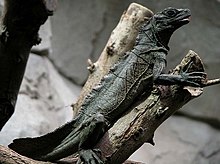| Hydrosaurus | |
|---|---|

| |
| Hydrosaurus amboinensis | |
| Scientific classification | |
| Domain: | Eukaryota |
| Kingdom: | Animalia |
| Phylum: | Chordata |
| Class: | Reptilia |
| Order: | Squamata |
| Suborder: | Iguania |
| Family: | Agamidae |
| Subfamily: | Hydrosaurinae Kaup, 1828 |
| Genus: | Hydrosaurus Kaup, 1828[1] |
| Type species | |
| Hydrosaurus amboinensis | |
| Species | |
| Synonyms | |
| |
Hydrosaurus, commonly known as the sailfin dragons or sailfin lizards, is a genus in the family Agamidae.[2] These relatively large lizards are named after the sail-like structure on their tails. They are native to Indonesia (4 species) and the Philippines (1 species) where they are generally found near water, such as rivers and mangrove.[3] Sailfin lizards are semiaquatic and able to run short distances across water using both their feet and tail for support, similar to the basilisks.[4] They are threatened by both habitat loss and overcollection for the wild animal trade.[3]
In the 19th century, the genus was called Lophura, however in 1903 Poche pointed out that the name was pre-occupied by a genus of pheasants.[5] Since Günther in 1873, the Sulawesi populations were considered to belong to H. amboinensis; Denzer et al. in 2020 resurrected H. celebensis and H. microlophus, increasing the number of species from three to five.[5]
They are the only members of the subfamily Hydrosaurinae.
- ^ Hydrosaurus, ITIS report
- ^ Hydrosaurus, The Reptile Database
- ^ a b Cameron D. Siler, Andrés Lira-Noriega, Rafe M. Brown (2014). Conservation genetics of Australasian sailfin lizards: Flagship species threatened by coastal development and insufficient protected area coverage. Biological Conservation 169: 100–108. doi:10.1016/j.biocon.2013.10.014
- ^ Jackman Bauer (2008). Global diversity of lizards in freshwater (Reptilia: Lacertilia). Hydrobiologia 595(1): 581–586.
- ^ a b Cite error: The named reference
Denzer2020was invoked but never defined (see the help page).